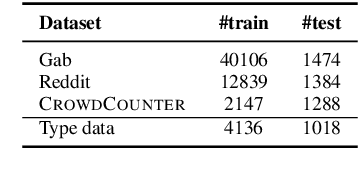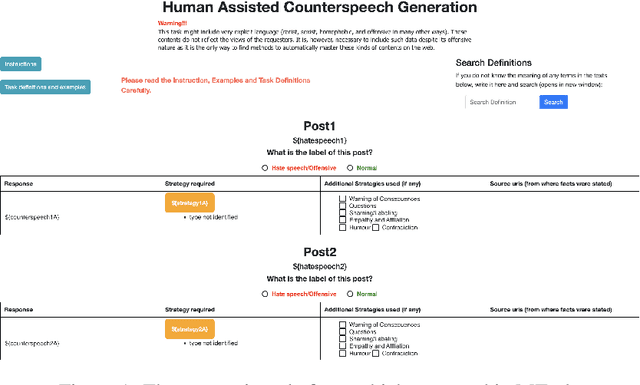Animesh Mukherjee
Exploring Disparity-Accuracy Trade-offs in Face Recognition Systems: The Role of Datasets, Architectures, and Loss Functions
Mar 18, 2025Abstract:Automated Face Recognition Systems (FRSs), developed using deep learning models, are deployed worldwide for identity verification and facial attribute analysis. The performance of these models is determined by a complex interdependence among the model architecture, optimization/loss function and datasets. Although FRSs have surpassed human-level accuracy, they continue to be disparate against certain demographics. Due to the ubiquity of applications, it is extremely important to understand the impact of the three components -- model architecture, loss function and face image dataset on the accuracy-disparity trade-off to design better, unbiased platforms. In this work, we perform an in-depth analysis of three FRSs for the task of gender prediction, with various architectural modifications resulting in ten deep-learning models coupled with four loss functions and benchmark them on seven face datasets across 266 evaluation configurations. Our results show that all three components have an individual as well as a combined impact on both accuracy and disparity. We identify that datasets have an inherent property that causes them to perform similarly across models, independent of the choice of loss functions. Moreover, the choice of dataset determines the model's perceived bias -- the same model reports bias in opposite directions for three gender-balanced datasets of ``in-the-wild'' face images of popular individuals. Studying the facial embeddings shows that the models are unable to generalize a uniform definition of what constitutes a ``female face'' as opposed to a ``male face'', due to dataset diversity. We provide recommendations to model developers on using our study as a blueprint for model development and subsequent deployment.
REVERSUM: A Multi-staged Retrieval-Augmented Generation Method to Enhance Wikipedia Tail Biographies through Personal Narratives
Feb 17, 2025Abstract:Wikipedia is an invaluable resource for factual information about a wide range of entities. However, the quality of articles on less-known entities often lags behind that of the well-known ones. This study proposes a novel approach to enhancing Wikipedia's B and C category biography articles by leveraging personal narratives such as autobiographies and biographies. By utilizing a multi-staged retrieval-augmented generation technique -- REVerSum -- we aim to enrich the informational content of these lesser-known articles. Our study reveals that personal narratives can significantly improve the quality of Wikipedia articles, providing a rich source of reliable information that has been underutilized in previous studies. Based on crowd-based evaluation, REVerSum generated content outperforms the best performing baseline by 17% in terms of integrability to the original Wikipedia article and 28.5\% in terms of informativeness. Code and Data are available at: https://github.com/sayantan11995/wikipedia_enrichment
* Accepted at COLING2025 Industry Track
RA-MTR: A Retrieval Augmented Multi-Task Reader based Approach for Inspirational Quote Extraction from Long Documents
Feb 17, 2025Abstract:Inspirational quotes from famous individuals are often used to convey thoughts in news articles, essays, and everyday conversations. In this paper, we propose a novel context-based quote extraction system that aims to extract the most relevant quote from a long text. We formulate this quote extraction as an open domain question answering problem first by employing a vector-store based retriever and then applying a multi-task reader. We curate three context-based quote extraction datasets and introduce a novel multi-task framework RA-MTR that improves the state-of-the-art performance, achieving a maximum improvement of 5.08% in BoW F1-score.
* Accepted at COLING2025-MAIN
Multilingual and Explainable Text Detoxification with Parallel Corpora
Dec 16, 2024Abstract:Even with various regulations in place across countries and social media platforms (Government of India, 2021; European Parliament and Council of the European Union, 2022, digital abusive speech remains a significant issue. One potential approach to address this challenge is automatic text detoxification, a text style transfer (TST) approach that transforms toxic language into a more neutral or non-toxic form. To date, the availability of parallel corpora for the text detoxification task (Logachevavet al., 2022; Atwell et al., 2022; Dementievavet al., 2024a) has proven to be crucial for state-of-the-art approaches. With this work, we extend parallel text detoxification corpus to new languages -- German, Chinese, Arabic, Hindi, and Amharic -- testing in the extensive multilingual setup TST baselines. Next, we conduct the first of its kind an automated, explainable analysis of the descriptive features of both toxic and non-toxic sentences, diving deeply into the nuances, similarities, and differences of toxicity and detoxification across 9 languages. Finally, based on the obtained insights, we experiment with a novel text detoxification method inspired by the Chain-of-Thoughts reasoning approach, enhancing the prompting process through clustering on relevant descriptive attributes.
Efficient Continual Pre-training of LLMs for Low-resource Languages
Dec 13, 2024Abstract:Open-source Large Language models (OsLLMs) propel the democratization of natural language research by giving the flexibility to augment or update model parameters for performance improvement. Nevertheless, like proprietary LLMs, Os-LLMs offer poorer performance on low-resource languages (LRLs) than high-resource languages (HRLs), owing to smaller amounts of training data and underrepresented vocabulary. On the other hand, continual pre-training (CPT) with large amounts of language-specific data is a costly proposition in terms of data acquisition and computational resources. Our goal is to drastically reduce CPT cost. To that end, we first develop a new algorithm to select a subset of texts from a larger corpus. We show the effectiveness of our technique using very little CPT data. In search of further improvement, we design a new algorithm to select tokens to include in the LLM vocabulary. We experiment with the recent Llama-3 model and nine Indian languages with diverse scripts and extent of resource availability. For evaluation, we use IndicGenBench, a generation task benchmark dataset for Indic languages. We experiment with various CPT corpora and augmented vocabulary size and offer insights across language families.
On the effective transfer of knowledge from English to Hindi Wikipedia
Dec 07, 2024Abstract:Although Wikipedia is the largest multilingual encyclopedia, it remains inherently incomplete. There is a significant disparity in the quality of content between high-resource languages (HRLs, e.g., English) and low-resource languages (LRLs, e.g., Hindi), with many LRL articles lacking adequate information. To bridge these content gaps, we propose a lightweight framework to enhance knowledge equity between English and Hindi. In case the English Wikipedia page is not up-to-date, our framework extracts relevant information from external resources readily available (such as English books) and adapts it to align with Wikipedia's distinctive style, including its \textit{neutral point of view} (NPOV) policy, using in-context learning capabilities of large language models. The adapted content is then machine-translated into Hindi for integration into the corresponding Wikipedia articles. On the other hand, if the English version is comprehensive and up-to-date, the framework directly transfers knowledge from English to Hindi. Our framework effectively generates new content for Hindi Wikipedia sections, enhancing Hindi Wikipedia articles respectively by 65% and 62% according to automatic and human judgment-based evaluations.
DENOASR: Debiasing ASRs through Selective Denoising
Oct 22, 2024Abstract:Automatic Speech Recognition (ASR) systems have been examined and shown to exhibit biases toward particular groups of individuals, influenced by factors such as demographic traits, accents, and speech styles. Noise can disproportionately impact speakers with certain accents, dialects, or speaking styles, leading to biased error rates. In this work, we introduce a novel framework DENOASR, which is a selective denoising technique to reduce the disparity in the word error rates between the two gender groups, male and female. We find that a combination of two popular speech denoising techniques, viz. DEMUCS and LE, can be effectively used to mitigate ASR disparity without compromising their overall performance. Experiments using two state-of-the-art open-source ASRs - OpenAI WHISPER and NVIDIA NEMO - on multiple benchmark datasets, including TIE, VOX-POPULI, TEDLIUM, and FLEURS, show that there is a promising reduction in the average word error rate gap across the two gender groups. For a given dataset, the denoising is selectively applied on speech samples having speech intelligibility below a certain threshold, estimated using a small validation sample, thus ameliorating the need for large-scale human-written ground-truth transcripts. Our findings suggest that selective denoising can be an elegant approach to mitigate biases in present-day ASR systems.
Navigating the Cultural Kaleidoscope: A Hitchhiker's Guide to Sensitivity in Large Language Models
Oct 15, 2024



Abstract:As LLMs are increasingly deployed in global applications, the importance of cultural sensitivity becomes paramount, ensuring that users from diverse backgrounds feel respected and understood. Cultural harm can arise when these models fail to align with specific cultural norms, resulting in misrepresentations or violations of cultural values. This work addresses the challenges of ensuring cultural sensitivity in LLMs, especially in small-parameter models that often lack the extensive training data needed to capture global cultural nuances. We present two key contributions: (1) A cultural harm test dataset, created to assess model outputs across different cultural contexts through scenarios that expose potential cultural insensitivities, and (2) A culturally aligned preference dataset, aimed at restoring cultural sensitivity through fine-tuning based on feedback from diverse annotators. These datasets facilitate the evaluation and enhancement of LLMs, ensuring their ethical and safe deployment across different cultural landscapes. Our results show that integrating culturally aligned feedback leads to a marked improvement in model behavior, significantly reducing the likelihood of generating culturally insensitive or harmful content. Ultimately, this work paves the way for more inclusive and respectful AI systems, fostering a future where LLMs can safely and ethically navigate the complexities of diverse cultural landscapes.
CrowdCounter: A benchmark type-specific multi-target counterspeech dataset
Oct 02, 2024



Abstract:Counterspeech presents a viable alternative to banning or suspending users for hate speech while upholding freedom of expression. However, writing effective counterspeech is challenging for moderators/users. Hence, developing suggestion tools for writing counterspeech is the need of the hour. One critical challenge in developing such a tool is the lack of quality and diversity of the responses in the existing datasets. Hence, we introduce a new dataset - CrowdCounter containing 3,425 hate speech-counterspeech pairs spanning six different counterspeech types (empathy, humor, questioning, warning, shaming, contradiction), which is the first of its kind. The design of our annotation platform itself encourages annotators to write type-specific, non-redundant and high-quality counterspeech. We evaluate two frameworks for generating counterspeech responses - vanilla and type-controlled prompts - across four large language models. In terms of metrics, we evaluate the responses using relevance, diversity and quality. We observe that Flan-T5 is the best model in the vanilla framework across different models. Type-specific prompts enhance the relevance of the responses, although they might reduce the language quality. DialoGPT proves to be the best at following the instructions and generating the type-specific counterspeech accurately.
Sponsored is the New Organic: Implications of Sponsored Results on Quality of Search Results in the Amazon Marketplace
Jul 26, 2024



Abstract:Interleaving sponsored results (advertisements) amongst organic results on search engine result pages (SERP) has become a common practice across multiple digital platforms. Advertisements have catered to consumer satisfaction and fostered competition in digital public spaces; making them an appealing gateway for businesses to reach their consumers. However, especially in the context of digital marketplaces, due to the competitive nature of the sponsored results with the organic ones, multiple unwanted repercussions have surfaced affecting different stakeholders. From the consumers' perspective the sponsored ads/results may cause degradation of search quality and nudge consumers to potentially irrelevant and costlier products. The sponsored ads may also affect the level playing field of the competition in the marketplaces among sellers. To understand and unravel these potential concerns, we analyse the Amazon digital marketplace in four different countries by simulating 4,800 search operations. Our analyses over SERPs consisting 2M organic and 638K sponsored results show items with poor organic ranks (beyond 100th position) appear as sponsored results even before the top organic results on the first page of Amazon SERP. Moreover, we also observe that in majority of the cases, these top sponsored results are costlier and are of poorer quality than the top organic results. We believe these observations can motivate researchers for further deliberation to bring in more transparency and guard rails in the advertising practices followed in digital marketplaces.
 Add to Chrome
Add to Chrome Add to Firefox
Add to Firefox Add to Edge
Add to Edge